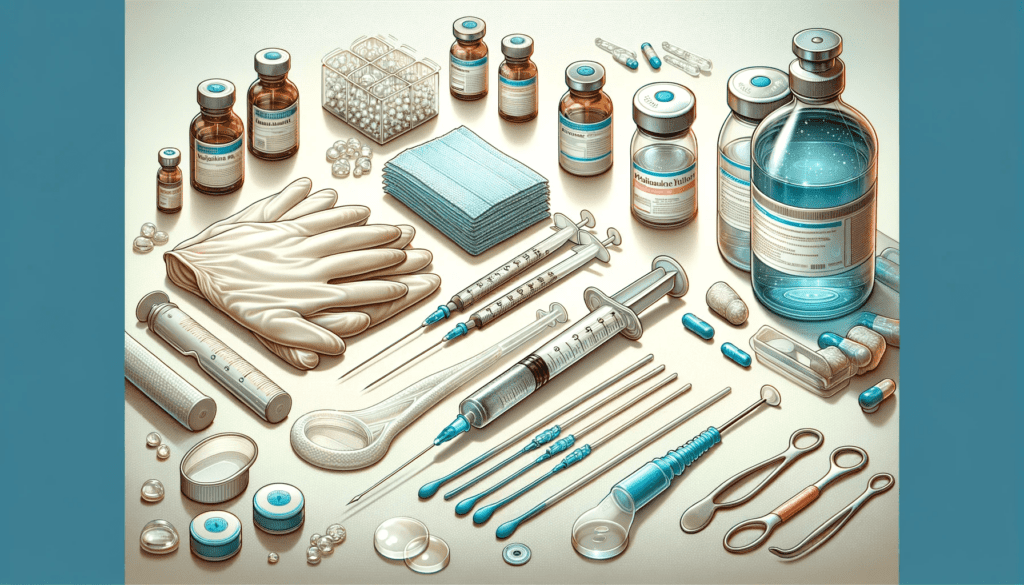Intravenous drug use carries inherent risks beyond overdose and addiction – it also poses a significant risk of wound development and infection. Wounds among people who use drugs are primarily caused by unsterile injection techniques, repeated injections in the same site, and compromised skin integrity. These wounds can escalate into serious complications if not properly managed. Let’s figure out what we can do about it.
Possible Complications

To begin with, a brief overview of what the injectable route of administration threatens any person with.
- Abscesses: Bacteria can enter the body through needle punctures, leading to the collection of pus and tissue inflammation.
- Cellulitis: A bacterial infection of the skin and tissues beneath, causing redness, swelling, and pain.
- Thrombophlebitis: Inflammation of a vein due to a blood clot, which can lead to swelling and blockage.
- Endocarditis: A serious infection of the heart valves, which can be life-threatening.
- Necrotizing Fasciitis: A rare but severe bacterial infection that causes tissue death, often referred to as “flesh-eating disease.”
- Wound Botulism: Caused by toxins from the bacterium Clostridium botulinum, which can paralyze muscles, including those used for breathing.
- HIV and Hepatitis C: Both can be transmitted through shared needles, further complicating any existing wounds.
Minimizing Risks of Injection-Related Injuries

Adhering to these guidelines each time you inject can significantly reduce the likelihood of injection-related issues.
Preparation is crucial
- Ensure hand cleanliness by washing with soap and water, or using a hand sanitizer.
- Clean the area of injection with soap and water. In the absence of soap and water, an alcohol prep pad is an alternative. Use it by wiping outward from the intended injection point. Injecting into an area that is not clean may increase the risk of infection.
- Whenever possible, use new injecting equipment each time. This includes a new cooker, cotton, syringe, and water, as they can harbor bacteria.
- Preferably use sterile water, sterile saline, tap water, or water from a sealed bottle. If unavailable, water from an opened bottle can be a substitute.
- It’s crucial to filter your solution and use a new filter for each injection. Filtration removes particles that could cause blood clots. Reusing filters or cotton can introduce mold and bacteria, leading to conditions like cotton fever or sepsis.
Choose the right sites
- The arms and legs are the most advisable injection sites due to their better circulation, leading to quicker healing.
- The hands and feet are alternative sites, though they are further from the heart. Remember, even small injection sites take 2-3 days to heal.
- Vary your injection site slightly each time to allow healing. Switching veins can also be beneficial as they need time to recover.
- Avoid injecting in high-risk areas such as the wrists, groin, neck, and arteries, where there is a higher concentration of nerves and blood vessels, increasing the risk of severe damage, pain, and infection.
If you can, steer clear of injecting pills, as they often contain binders that can severely harm your veins and lead to significant health problems.
Enhancing the Healing of Injection Sites

Immediate Post-Injection Care: After the injection site has clotted, begin with gentle cleaning. Use a mild, non-irritating antiseptic to disinfect the area. For example, a benzalkonium chloride (BZK) wipe will fit. This step is crucial to prevent infections, which can exacerbate scarring and track marks.
Application of Healing Agents: Once the site has closed or formed a scab, apply healing and moisturizing agents. Options include:
- Aloe Vera Gel: Known for its soothing and healing properties, aloe vera can reduce inflammation and promote skin regeneration.
- Cocoa Butter: This natural fat provides deep moisturization, which can help in reducing the appearance of scars.
- Vitamin E Oil: Renowned for its skin-healing properties, vitamin E can help in repairing tissue damage and fading scars.
Use of Antibiotic Creams: For sites that are healing but still vulnerable, consider using a triple antibiotic ointment. This can prevent bacterial infections, which can worsen scarring. Applying it before bedtime is effective, as the body’s regenerative processes are more active during sleep.
Long-term Skin Care Strategy: Incorporate a regular skincare routine that keeps your skin hydrated and healthy. Regular use of moisturizers can maintain skin elasticity, reducing the long-term impact of repeated injections.
Remember, each step you take towards proper care of injection sites not only aids in reducing track marks but also plays a critical role in your overall health and well-being.
Managing Missed Shots

When an injection is missed, meaning the substance was deposited into the tissue instead of the vein, it’s crucial to manage the site effectively to prevent complications like infections or abscesses. Here are some safe and helpful steps:
- Immediate Post-Injection Care: Wait until the injection site has started to close, which usually occurs a few hours after injecting, before applying any creams or oils. Early application can trap bacteria in the wound and delay healing.
- Cleaning the Injection Site: Use antimicrobial soap and water to gently clean the area. Choose soaps that are free from scents and alcohol to avoid irritation. After cleaning, gently pat the area dry with a clean towel.
- Warm Compresses: Apply a warm compress several times a day. This can help reduce irritation and the risk of abscess formation while increasing blood flow to aid healing. A warm compress can be a clean warm towel, a hand warmer, or a homemade rice sock compress (uncooked rice in a clean sock, heated in the microwave for short intervals until warm, but not hot enough to burn the skin). If using a warm compress, you can use a cut sock or a soft cloth to hold it in place, ensuring it’s secure but not too tight.
- Covering the Site: Keep the area clean and covered with a sterile dressing until any drainage ceases. This protects against infection and further irritation.
- Facilitating Vein Access for Future Injections:
- Stay Hydrated: Adequate hydration can make veins more prominent and easier to access.
- Warm Up the Injection Site: Applying a warm cloth or taking a hot shower can help bring the veins to the surface.
- Light Exercise: Physical activity, like walking or arm exercises, can increase blood flow and make veins more visible.
- Steamy Environment: A steamy bathroom can also help in making the veins more accessible.
Understanding Abscesses

What is an Abscess? An abscess is a localized infection that occurs when bacteria enter the body, often through a break in the skin. It’s a defensive response by your immune system to isolate and combat the infection.
Formation: Abscesses often develop after practices like skin popping (subcutaneous injections), muscling (intramuscular injections), or missing a vein (extravasation), especially in the context of substance use.
Appearance: They typically appear as swollen, red, and tender lumps at the injection site. The area might feel warm and painful, as the body concentrates its immune response there.
Cause: While abscesses are more related to bacterial infection than the specific substance injected, certain practices like injecting stimulants (e.g., methamphetamine, cocaine) subcutaneously or intramuscularly can increase the risk.
Key Points in Abscess Care
- Early Intervention: Prompt treatment of abscesses is crucial to prevent serious complications, such as the spread of infection or septicemia (blood poisoning).
- Avoid Self-Incision: Do not attempt to cut or squeeze an abscess. This can cause further damage, including severing blood vessels, and may spread the infection deeper or into the bloodstream.
- Use of Warm Compresses: Applying warm compresses can aid in bringing the infection closer to the skin’s surface, promoting drainage and alleviating discomfort. Ensure the compress is clean and warm (not hot) to avoid skin damage.
- Prevention Strategies: Employing safe injection practices is key in preventing abscesses. This includes using sterile equipment, rotating injection sites, proper cleaning of the skin before injection, and avoiding reuse of needles.
- Aftercare: Once an abscess is treated, follow up with proper wound care. Keep the area clean, covered, and monitor for signs of infection.
- Medical Consultation: Seek professional medical care for an abscess, especially if it’s large, extremely painful, or shows signs of spreading infection (increased redness, streaking, fever). Healthcare providers can safely drain it and may prescribe antibiotics if needed.
Remember, taking proactive steps in managing your health and seeking timely medical intervention when needed are essential in effectively handling abscesses and maintaining overall well-being. Below I will focus in more detail on how to treat an abscess before and after drainage.
Abscess Treating Before Drainage
- Initial Steps and Cleaning:
- Hand Hygiene: Begin by thoroughly washing your hands with soap and water to prevent the spread of bacteria.
- Avoid Aggravating the Abscess: Do not squeeze, press, or pick at the abscess. Such actions can push the infection deeper into your tissues or into the bloodstream, potentially leading to sepsis (blood poisoning) and delaying healing.
- Tracking the Abscess Size: Draw a circle with a skin-safe marker around the outer edge of the swollen area. This helps monitor its growth. If the abscess expands beyond the circle within 24-48 hours, or if you notice increasing pain, redness, or fever, seek medical attention promptly, as these could be signs of a worsening infection.
- Warm Compresses: Apply a warm compress to the abscess 3-4 times daily for 10-15 minutes each session. This can help reduce swelling and promote circulation, aiding the body’s natural healing process. Ensure the compress is comfortably warm but not so hot as to burn the skin. Suitable options include warm towels, hand warmers, or a homemade rice sock compress (uncooked rice in a clean sock, heated in a microwave).
- Elevate the Affected Area: If feasible, elevate the area with the abscess during and after using the warm compress. This can help reduce swelling and inflammation.
- Applying Antibiotic Ointment: If the abscess is not open or draining, you can apply an over-the-counter antibiotic ointment. This may help prevent superficial skin infections from spreading. However, it is not a substitute for professional medical treatment if the abscess worsens.
- Bandaging and Hygiene:
- Covering the Abscess: After applying heat and/or antibiotic ointment, cover the area with a clean, dry bandage or wrap it in gauze. Change the bandage frequently to maintain cleanliness.
- Disposing of Contaminated Materials: Dispose of any material that comes into contact with the abscess fluid in a sealed plastic bag to avoid spreading infection.
- Gentle Removal of Dressings: If bandages stick to the wound, moisten them with saline or warm water before gently removing to avoid damaging healing tissue.
- Monitoring for Drainage: Over time, an abscess may develop a “head” and start to drain naturally. Discontinue the use of warm compresses if this occurs.
- Evaluating Healing Progress: If the abscess is shrinking, becoming less red, less swollen, and the drainage does not have a foul odor, and you do not observe red streaks or other concerning symptoms, continue with these care steps. However, if there are signs of tissue necrosis (skin turning green, purple, or black on lighter skin), a foul odor, or other alarming changes, seek emergency medical care immediately.
- Seeking Medical Attention: Always be vigilant for signs of worsening infection or complications. While some abscesses may resolve with careful home care, others require medical intervention, particularly if there’s a risk of serious infection or other complications.
Post-Drainage Abscess Caring
Proper care after an abscess has drained is crucial to prevent reinfection and promote healing. Here are safe and effective steps:
- Hand Hygiene: As always, start by thoroughly washing your hands with soap and water. This is essential to prevent the introduction of new bacteria to the healing area.
- Cleaning the Surrounding Skin: Gently clean the skin around the drained abscess with a BZK towelette or a mild, non-irritating antiseptic wipe. This helps remove any contaminants that might cause reinfection.
- Rinsing the Abscess Site: Carefully rinse the abscess cavity with soap and water or a saline solution. This can be done by gently applying the solution with a clean cloth or gauze, being careful not to rub or irritate the area.
- Keeping the Area Dry and Clean: After cleaning, pat the area dry with a clean, soft towel. It’s important to keep the abscess site dry to aid in healing and prevent bacterial growth.
- Applying a Dressing: Cover the abscess with sterile gauze and secure it with a band-aid or medical tape. This protects the area from dirt and reduces the risk of infection.
- Allowing the Abscess to Breathe: Once a day, after cleaning the area thoroughly, leave the abscess uncovered for about 20 minutes. This airing out can promote healing. Ensure the environment is clean during this time to avoid contamination.
- Routine Care: Repeat this cleaning and dressing process twice daily until the abscess heals completely. Consistency is key in preventing complications and promoting effective healing.
- Monitor Healing Progress: Keep an eye on the healing process. If the area shows signs of increased redness, swelling, warmth, or if you notice a fever or other signs of infection, seek medical attention. These could be indicators that further medical intervention is needed.
- Avoid Repeated Irritation: Be cautious not to aggravate the area. Avoid tight clothing or activities that might apply pressure or friction to the abscess site.
- Consult Healthcare Providers if Needed: If you have any doubts or concerns about the healing process, or if the abscess was particularly large or severe, don’t hesitate to consult a healthcare provider for advice and potentially necessary treatment.
Proper aftercare of a drained abscess is vital for complete recovery and minimizes the risk of future complications. Always prioritize cleanliness and gentle care during the healing process.
Antibiotics for Abscesses

Determining the Need for Antibiotics:
- Size and Severity Assessment: Generally, for an abscess smaller than 2 cm (about the size of a penny or bottle cap), antibiotics may not be necessary if you’re otherwise healthy. However, this doesn’t rule out the need for medical intervention. A healthcare professional might still need to perform an incision and drainage to properly treat the abscess.
- Health Conditions and Risks: If you have certain health conditions like a fever, multiple abscesses, a history of endocarditis, HIV, diabetes, or if you are immunocompromised, the likelihood that you’ll need antibiotics increases. These conditions can affect your body’s ability to fight off infection, making antibiotic treatment more critical.
Proper Use of Prescribed Antibiotics:
- Completing the Course: If you are prescribed antibiotics, it’s crucial to complete the entire course as directed by your healthcare provider, even if you start feeling better before finishing them. Stopping early can lead to antibiotic resistance or a resurgence of the infection.
- Individualized Treatment: Avoid sharing antibiotics. Antibiotic regimens are tailored to individual needs and conditions. What is effective for one person may not be appropriate for another and can lead to complications.
- Duration and Monitoring: A typical course of antibiotics can last from 7 to 14 days, depending on the abscess’s size, severity, and your overall health. Monitor your condition closely. If there is no improvement or if symptoms worsen within 24-48 hours of starting antibiotics, seek medical attention. This could indicate that the antibiotic is not effectively targeting the specific bacteria causing the infection.
- Seeking Follow-Up Care: In cases where the infection is severe or deeply situated, intravenous (IV) antibiotics might be necessary. If you suspect the infection is not responding to oral antibiotics, or if symptoms are escalating, it’s important to contact a healthcare provider promptly.
When to Seek Medical Attention

If your abscess is large, extremely painful, or smells bad, it’s important to seek medical attention from a professional ASAP.
Visit a Doctor:
- Abscess Growth and Pain: If the red bump (abscess) grows larger than the marked area, becomes more painful, or feels hot to the touch, it’s time to see a doctor. These are signs that the infection may be worsening.
- Fever and Other Symptoms: A fever can indicate that the infection is spreading beyond the local site, possibly affecting larger areas of skin or internal organs, including the heart. This requires prompt medical evaluation.
- Location Over Major Artery: If the abscess is located over a major artery (where you can feel a pulse), it’s important to seek medical care due to the potential for more serious complications.
- Red Streaks from Infection Site: Red streaks extending from the abscess are a warning sign of spreading infection, often indicating cellulitis, which requires medical intervention.
- No Improvement: If there’s no sign of improvement after 5-7 days, or if the abscess continues to worsen, it’s crucial to get medical advice.
- Weakened Immune System: Individuals with compromised immune systems, due to conditions like HIV/AIDS, diabetes, cancer, etc., should consult a doctor as they are more susceptible to serious infections.
Go to the Emergency Department (ED):
- Severe Symptoms: Chest pains, chills, fever above 100.5°F (38°C), or feeling faint (which could signify low blood pressure or severe infection) are urgent symptoms, especially if you have pre-existing health conditions. This could mean the infection has spread to your heart or bloodstream.
- Rapid Spread of Infection: If the skin around the infection turns dark, or if the redness spreads quickly, seek immediate medical care. This could be a sign of necrotizing fasciitis, a severe and rapidly progressing infection.
- Symptoms of Wound Botulism: Vision problems, drooping eyelids, difficulty breathing, talking, swallowing, or a sore throat appearing 1-2 days after injecting, particularly in users of black tar heroin, could be symptoms of wound botulism. This is a rare but life-threatening condition that requires urgent medical attention.
- Abscess in Uninjected Areas: Finding an abscess in an area where you haven’t injected is a cause for concern and should be evaluated by a healthcare professional.
It’s important to monitor any abscess closely and to recognize signs that require medical attention. Early intervention can prevent more serious complications. Always err on the side of caution and consult a healthcare provider or visit the ED if you notice any concerning symptoms or changes in your condition.
Final Thought

For people who use drugs, wound prevention and careful management are key to avoiding serious health complications. It may seem to someone that detailed coverage of the nuances of how best to inject will contribute to the use and is generally harmful and contrary to medical principles. I want to refer such people to any of the articles devoted to a completely medical philosophy of Harm Reduction.
Moreover, following these principles, I plan to talk about things that I cannot approve of myself. For example, how to properly share one syringe. After all, everywhere everyone says bluntly – don’t do this. But people do. And the only honest and working offer for people who have made such a choice is to find out how to do it with the least harm to themselves.
By adopting safe injection practices, maintaining good hygiene, and seeking medical care when needed, the risk of wound-related issues can be significantly reduced. Community resources and harm reduction programs can provide support and education to those at risk. Remember, each step taken towards proper wound care is a move towards better overall health and wellbeing.




